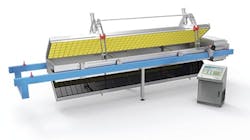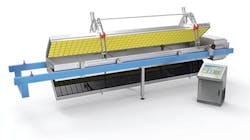Thermoformers taking interest in latest IR heaters
U.S. thermoformers increasingly are adopting new energy- and cost-saving technologies, according to two equipment suppliers."The best thermoformers in the world are now questioning and re-evaluating their heat technology and production efficiency," said Frank Wilson, founder and managing director of Ceramicx Ltd., Ballydehob, Ireland. Ceramicx is a global supplier of infrared (IR) heating systems and platens for thermoforming.
Ceramicx thermoforming heating systems consist of multiple IR ceramic heaters mounted on reflectors that are then arrayed on a platen. The company designs unique systems for each client, incorporating custom features that depend on the products manufactured, materials used and cycle times. The company also supplies heating systems that can be retrofitted to existing platens, and ovens that heat the sheet prior to forming.
Weco International, the U.S. distributor for Ceramicx, reports that a number of large thermo-
forming platen customers made purchases in 2017. Ceramicx commissioned a study about three years ago that found that using its IR technology for heating extruded plastic sheet prior to forming offered as much as a 40 percent energy savings compared with systems using Calrod-type tubular heating elements that convert electricity into heat.
Weco reports the energy-saving message is gaining traction in the U.S., pointing out that those companies that use large thermoforming platens — which require the most energy — are the customers most interested in the new technology.
For example, a few months ago, a U.S. client ordered a thermoforming platen measuring 15.1 feet by 8.9 feet for the production of bath and spa tubs. Such a large heating system, with a 281 kilowatt (kW) output, involves a considerable draw on power. Ceramicx designed and built the new thermoforming platen. It operates at 480 volts and has 10 individual control zones and 468 full-flat, hollow heating elements that are medium-wave emitters made of ceramic. The system shipped in November.
In December, Weco fulfilled an order for a refrigerator and freezer OEM. Again, the platen size was large, measuring 10.5 feet by 6.7 feet, with each platen containing 210 elements. This customer required 70 heat-control zones, each one with its own thermocouple and each zone containing three ceramic IR elements.
"In manufacturing, heavy users of utilities are likely to be extremely cost-conscious of their power consumption," said Brett Wehner, Weco president and CEO. "Many of our U.S. thermoforming customers are clearly in that category, both in continuous in-line thermoforming for industries including packaging and [fast-moving consumer goods] and also for large cut-sheet applications in automotive, aerospace and white goods."
One of the reasons the U.S. has been slow to adopt energy-saving IR heating technology is because electricity is inexpensive compared with other places in the world. But that's not preventing Ceramicx from making inroads in the U.S. market.
"Despite the advances in fracking and shale gas, U.S. manufacturing industry is still being incentivized to go green," Wilson said. "The key is [a] great IR thermoforming platen build … combined with pinpoint accurate electronic process and control."
The incentives are coming from a variety of state-level energy-saving programs, according to the company.
In addition to reducing energy consumption, Ceramicx's IR heating systems offer increased heating accuracy, speed and consistency, which increases production and reduces scrap and downtime, Wilson said.
Ceramicx systems also provide early-warning diagnostic features, including the ability to alert the operator in the event of the loss of a single heating element, a shorted wire or a bad fuse, Wilson said.
To install a new IR heating system in the platen of an existing thermoforming machine, Weco International typically spends three to four days on-site, including a 24-hour test run.
Some thermoformers might be put off by the cost of installing an entirely new thermoforming machine, but an upgrade to the heating system can improve the performance of an existing machine and typically pays for itself within a few months. A simple IR upgrade to a conventional heating system can increase profits for thermoformers by at least one-third, according to Ceramicx.
IR heaters can eliminate numerous problems, including burned material, electrical faults and other issues, that can result from inexact and non-directional heating when using older technologies like Calrods, according to Ceramicx.
American Thermoforming Machinery
American Thermoforming Machinery (ATM) reports increased interest among thermoformers in its more efficient IR ceramic and quartz heaters as replacements for older Calrod heaters.
For example, by using ATM equipment, a customer thermoforming large PE parts for recreational vehicles was able to reduce oven energy consumption by 25 percent. That reduced heat cycle times by 8 percent and increased production by six to eight parts per shift. Company President Danny Blasch calls those estimates conservative.
ATM's calculation is based on the results its customer experienced on a new ATM machine compared with an older machine at the same site from a different manufacturer, Blasch said.In addition to selling new thermoforming machines, ATM sells oven upgrades, which involve replacing old inefficient heaters and better insulating the ovens.
When equipped with zoning control, rebuilt ovens become much more energy efficient, Blasch said.
"Zoning control is extremely important in energy savings. Having the ability to completely turn off or lower the percentage of heat provided to zones that are not needed for a particular mold will save enormous amounts of energy over time," he said.
Blasch said changing out old Calrod-type heating elements with ceramic heaters in ovens and calibrating the proper zoning for customers' needs results in an average productivity increase of 65 percent. Energy consumption is reduced by more than 50 percent. In addition, unacceptable parts are virtually eliminated because precise control of the temperature results in more uniform part thicknesses.
Bruce Geiselman, senior staff reporter
For more information
American Thermoforming Machinery,West Branch, Mich., 989-345-0935, www.americanthermoformingmachinery.com
Weco International Inc.,Clio, Mich., 810-686-7221, www.wecointernational.com
About the Author
Bruce Geiselman
Senior Staff Reporter Bruce Geiselman covers extrusion, blow molding, additive manufacturing, automation and end markets including automotive and packaging. He also writes features, including In Other Words and Problem Solved, for Plastics Machinery & Manufacturing, Plastics Recycling and The Journal of Blow Molding. He has extensive experience in daily and magazine journalism.

